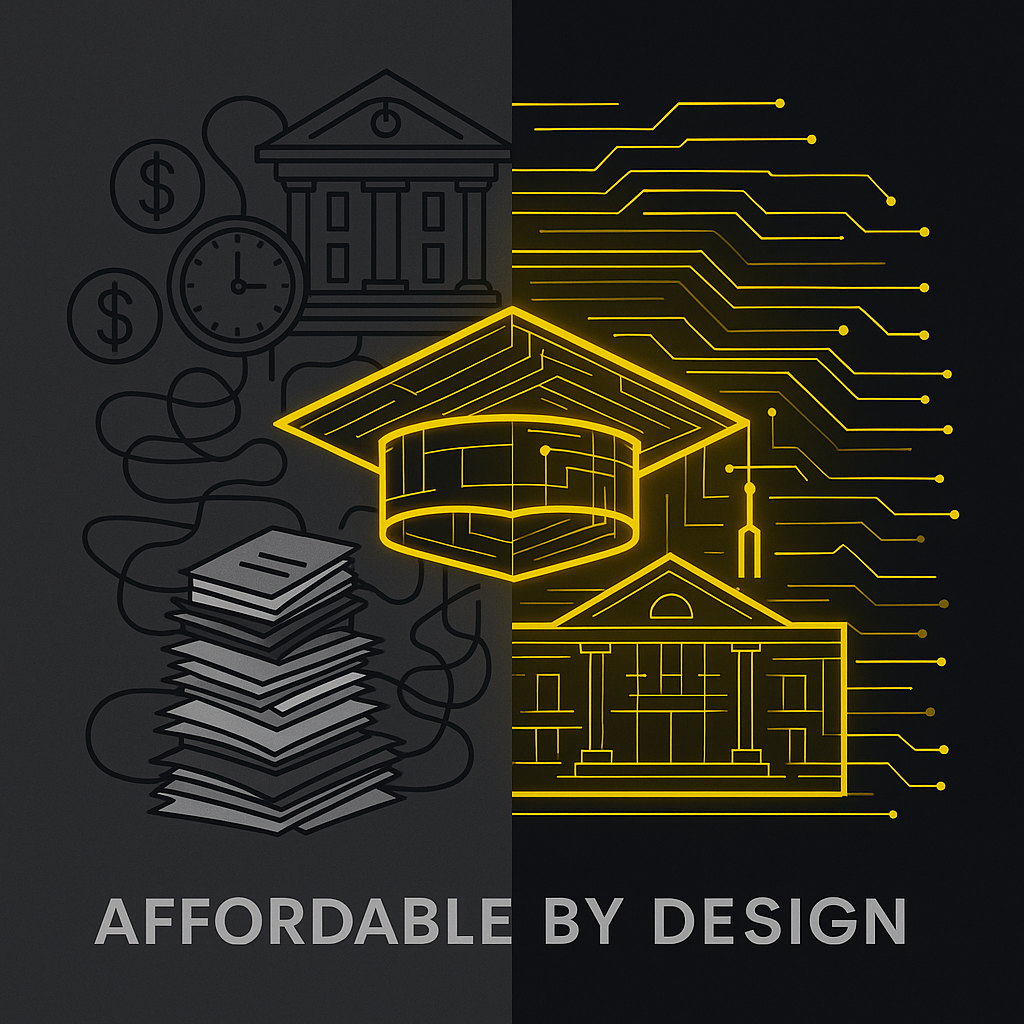In the United States alone, total student debt now exceeds $1.7 trillion, while tuition at leading universities regularly surpasses $50,000 a year. Yet less than 10% of the global population has a college degree, and only about a third of Americans hold one. That’s not just a market failure - it’s a moral one.
At Nexford, we’ve believed since day one that education should be designed differently - not only to be better, but to be fairer. And that belief is why our tuition is dramatically lower than most universities’.
Our affordability isn’t a promotional gimmick or a race to the bottom. It’s the result of design - a deliberate rethinking of how a modern university should operate.
Education is expensive not because it must be, but because it was built for another era.
When we launched Nexford, we asked a simple question: What actually drives the cost of education?
Back in February 2019, I wrote in “How Much Should Getting a College Education Really Cost?” that “students today pay for experience and administration - not for education.”
That hasn’t changed. Most universities still spend the majority of tuition revenue on everything except learning: maintaining expansive campus facilities, covering tenured faculty salaries, and sustaining multi-layered administrative structures.
Research shows that, on average, less than half of university budgets go toward academic purposes. The rest funds non-instructional costs - everything from marketing to student amenities - that, while pleasant, have little to do with actual learning.
Historically, that model made sense. Classroom sizes were limited; universities had to cover their fixed costs across relatively small numbers of students. But that constraint no longer exists. Today, technology allows us to scale quality education globally, yet most institutions still operate as if classroom walls define their reach.
Ironically, even with online delivery, costs haven’t dropped. According to Eduventures research, 83% of online degrees aren’t more affordable than their on-campus equivalents, largely because universities kept their legacy overheads or continue to price for perceived prestige. That perception of prestige is already eroding - and soon, it will be gone.
Trying to fix that model is like attempting to retrofit a 200-year-old mansion with solar panels - you’ll spend a fortune patching old wiring and still end up with a house that wasn’t designed for today’s world.
So we didn’t retrofit. We rebuilt.
By designing Nexford as a digital-first university from day one, we eliminated unnecessary overhead and focused every dollar on what matters: curriculum, technology, and learner success.
Affordability is a design principle, not a discount strategy.
We didn’t set our prices low to compete; we designed our entire model so that high quality could be delivered affordably.
When I wrote “How Netflix, Apple, and Tesla Have Inspired Me While Creating a University” in May 2019, I explained how Nexford’s flat, transparent pricing model was inspired by Netflix - clarity over complexity. No hidden fees, no confusing credit-hour math, just a simple structure that puts learners in control.
A full MBA costs roughly $3,600–$4,000 total, and a BBA in the U.S. starts at $250 per course - or about $10,000 for the full degree.
By design, that’s up to 90% more affordable than traditional U.S. programs - proof that when you rebuild the system efficiently, affordability follows naturally.
Fun fact: the “credit hour” - the backbone of how tuition is calculated today - wasn’t designed for learners at all. It was invented more than a century ago to determine how much faculty should be paid per class period. Paul LeBlanc, a mentor I deeply respect and admire, describes this brilliantly in his book Students First. It’s a perfect example of how historical systems still shape modern inefficiencies.
We designed for global accessibility, not government dependency.
Traditional universities rely heavily on Title IV federal loans, a model that masks true costs through government subsidies. But that system is unsustainable. U.S. public debt is ballooning, and outside the U.S., such loan schemes rarely exist.
When we built Nexford, we made a conscious decision not to depend on government funding. We wanted a model that could scale globally and sustainably - one where affordability wasn’t subsidized, but engineered.
That independence means we’re forced to offer real value. Every learner pays directly out of pocket, so our tuition must make sense in real economic terms. It’s a pure market signal of perceived value, not an artificially inflated figure made possible by easy loans.
AI + Human Insight: The Smartest Way to Build Efficiency at Scale
Technology should do what it does best - automate the routine, analyze data, and deliver consistency at scale. Humans should focus where they add the most value - empathy, creativity, mentorship, and judgment.
At Nexford, we apply this principle across our operations. AI handles thousands of learner inquiries that would once require large support teams. More importantly, we use advanced data analytics to design and update curricula.
Instead of relying solely on human committees to guess what employers want, we analyze millions of job postings and reports from the World Economic Forum, World Bank, IFC, and Burning Glass Institute. That data shapes our Workplace Alignment Model (WAM) - ensuring every course builds skills employers actually need.
Our faculty and experts then layer human insight on top of that analysis, refining and contextualizing it. The result: AI does the heavy lifting, humans bring the nuance - a scalable model that delivers both quality and efficiency.
Purpose before profit - by choice.
We could easily double tuition and reach half the number of learners. Instead, we choose the opposite - to maximize access and impact.
That decision isn’t philanthropic; it’s strategic. When fewer than 10% of the world’s population has a college degree, accessibility isn’t a nice-to-have - it’s a global necessity.
Mission-driven capital enables mission-driven design.
Building an entirely new kind of university doesn’t happen overnight. It requires long-term investment and patient capital. Nexford has raised over $40 million from mission-driven investors who believe in building education systems that are sustainable, scalable, and accessible.
Their support allowed us to invest in the infrastructure, AI systems, and quality frameworks that make true affordability - and world-class quality - possible.
The result: world-class, employer-aligned education at a fair price.
In “Can an Online Advanced Degree Really Be as Good as a Brick-and-Mortar One?” (August 2019), I argued that online universities would eventually match - and in many cases surpass - traditional ones. That prediction has proven true.
Today, more students in America are enrolled in online programs than in traditional campus-based ones - clear proof that the market is voting with its feet.
And the outcomes speak for themselves. In our most recent Nexford Alumni Outcomes Report, 98% of alumni reported that Nexford improved their career prospects, and 70% received a salary increase or new job opportunity within months of graduating.
When efficiency meets purpose, quality and affordability can coexist. Nexford’s model shows that world-class, employer-aligned education doesn’t have to cost a lifetime of debt.
This isn’t a new revelation for us. It’s the continuation of the same principles that guided Nexford’s founding - rethinking education from first principles, with efficiency, technology, and impact at its core.
That’s why Nexford is affordable.
And that’s why, one day, all universities that continue to exist will need to be.







